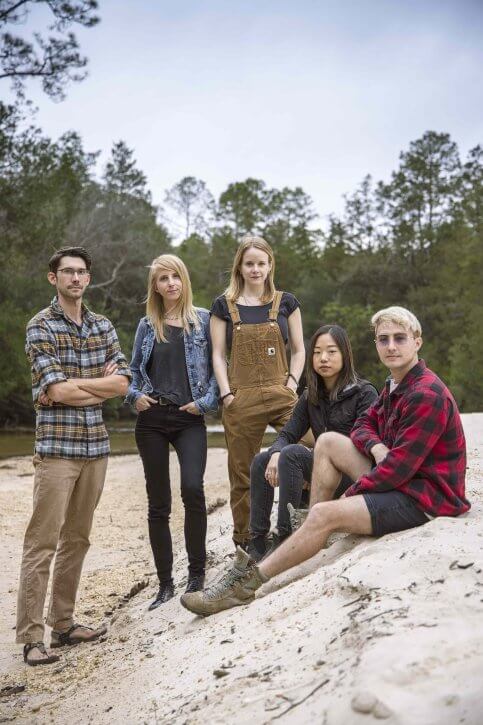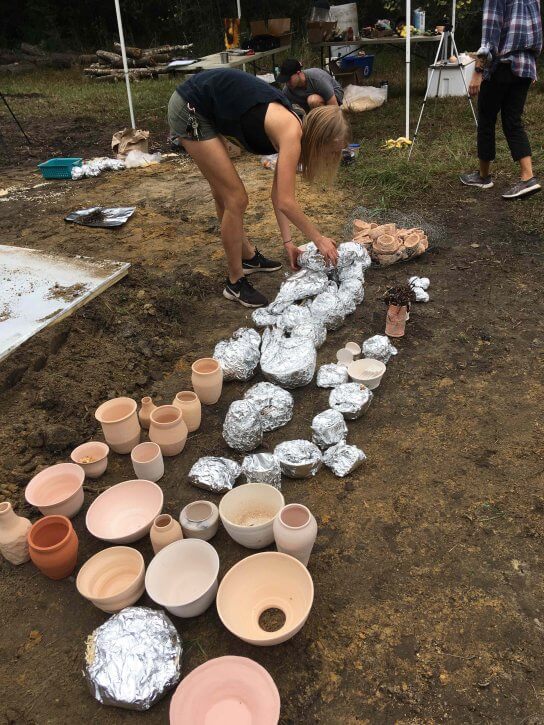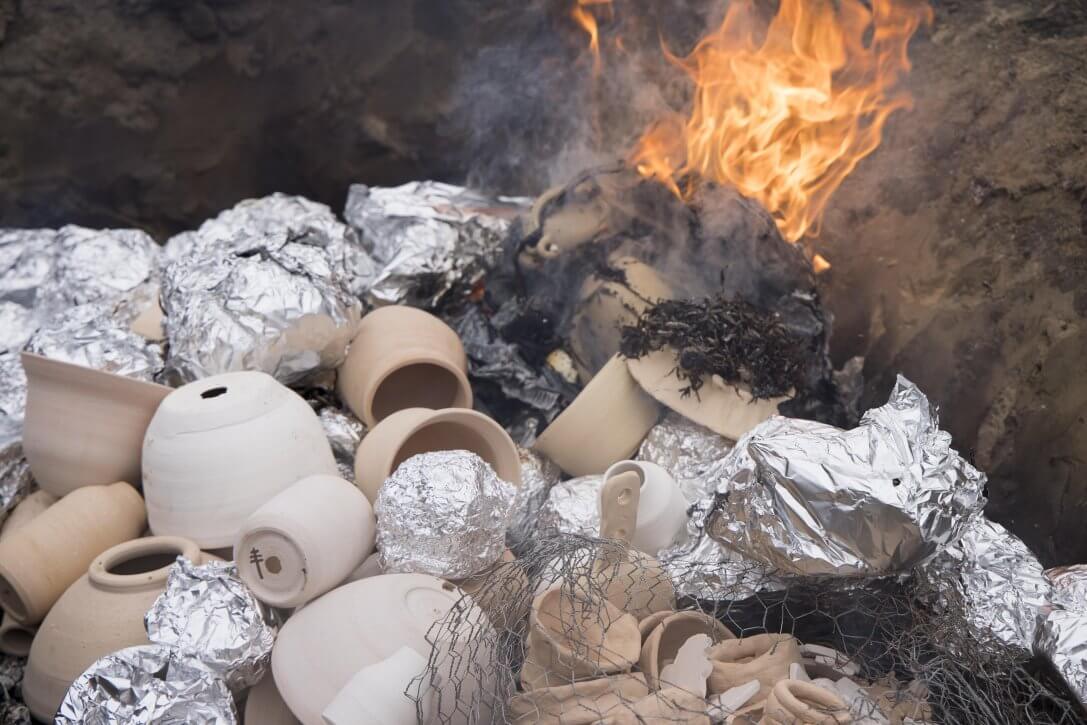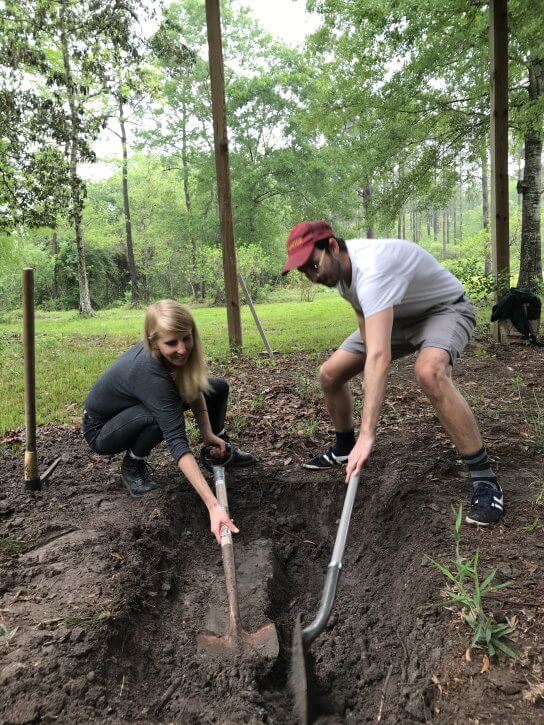
Long before electric and gas kilns became the cornerstone of the ceramics industry, pottery was hand formed and fired within the dirt and flaming embers of pit fires and open bonfires. Pit firing is the oldest form of baking, or firing, clay pottery and dates back more than 30,000 years ago. Just as the name suggests, pit firing involves digging out a pit in the ground, starting a fire to dry out the wet earth and build up a bed of hot embers, laying clay pieces in the pit, covering them with combustible material, setting the pit ablaze and allowing the fire to burn for several hours until it is cool enough to uncover the pieces. While this method of firing and finishing pottery is not as widely or commonly practiced as firing in modern-day kilns, pit firing creates a unique aesthetic finish on ceramic wares, carries a smaller carbon footprint and can promote both sustainable and accessible art practices. One group of local artists have spent the better part of a year researching, designing pits and educating others through their pit firing collective. From left to right: Current pit-fire collective members include Nick Phoenix, Eniko Ujj, Cat Gambel, Katie Soo and Kyle Miller.
Local artists Eniko Ujj and Cat Gambel first became interested in alternative firing methods when they attended a weekend-long creative workshop in collaboration with New Orleansbased composer, James May, and hosted by Dr. John Clark, Professor Emeritus of Loyola University, at Bayou La Terre Institute for Social Ecology. Here they explored memory, social ecology, the sonic environment and worked as a group to fire handmade clay rattles in a pit fire. Ujj and Gambel became enthralled with the pit firing process in preparation for this workshop in early 2021 and began organizing pit fires together in their own back yards. The two teamed up with fellow friends and artists and formed a core group of pit-firing enthusiasts that include Eniko Ujj, Cat Gambel, Kyle Miller, Nick Phoenix and Katie Soo.
This collective works together to harvest and process wild clay from the Blackwater River system, collect fallen debris from storms in the longleaf pine ecosystem to help with the prescribed burn process and organize a monthly group pit fire in a variety of locations, including the eco-resort, Coldwater Gardens in Milton, FL.
“I consider building and preparing the pits a form of tactile therapy just like working with clay,” Ujj explained. “You’re constantly touching and building and involved with the entire process from collecting the wood to monitoring the temperature during the fire unlike with a programmable kiln where you can put your pieces in and forget about them. I also think there is such a magical quality to pit firing when you finally get to unearth and dig out your ceramics to see what happened—that’s probably my favorite part.”
This magical and unpredictable quality of pit firing is part of the atmospheric process within the pit where the colors and patterns are derived from what is consumed and burned within the fire—as opposed to colors added to ceramics with glaze finishes. The combustible items like eggshells, banana peels, avocado skin, animal poop, dried flowers, seaweed and other natural items added to the pit will turn to vapor and swirl around the pottery in the pit. Each combustible is a new colorant experiment, and pit fired pottery is most striking for its natural tones of black, gray and white with pops of sporadic color from the combustibles.

“I think kilns offer more predictability and stability,” Gambel explained. “Pieces fired with the pit method are not food safe or water-tight, so there are fewer functional options for ceramicists. All of the materials burning together affect the surface of the clay and the results are hard to repeat. In one firing, many of our pieces came out with gorgeous splashes of red; in another we had specks of blue. We have theories on what causes these colors, and there is some research, but it is impossible to get a very specific color in a specific way—so much is chance and trusting the beauty of what can’t be controlled.”
While pit-fired pottery is porous and not food safe or water-tight, our ancestors traditionally used a number of materials and different techniques to waterproof their ceramics by coating the inside of them with tree sap, pine resin, animal fats and waxes before glazing was invented.
Much of the process of the collective has been dedicated to research, designing pits and recording the results of their pit fires as very little research and data exists on this ancient method. The group received funding and equipment from a grant by the Office of Undergraduate Research (OUR) at the University of West Florida. Kyle Miller, a student in the art department at UWF, applied for the grant with Cat Gambel, the Director of The Art Gallery (TAG) at UWF, as his faculty advisor. The OUR grant funded much-needed safety equipment for handling the fire and hot pottery and allowed the group to purchase a commercial pyrometer to accurately measure the pit temperature and aid in data collection.
“You can already see the difference from the beginning to where we are now. Our initial pit fires took days to finish and now we can do the entire process in six hours because we know the exact temperatures and timing for each step of the process,” Miller explained.
“The firing process itself takes roughly two hours. Then you have to let the pieces cool naturally. There is an element of thermal shock that you have to be aware of so the pieces don’t break. It’s all very technical. If the pieces that are on top are too heavy, they’ll crack the pottery. If your fire gets too hot, too fast, you’ll crack the pottery. If your fire gets cold too fast, you’ll crack in the pottery. There are a lot of instances where you can crack the pottery.”
By studying the scientific method of pit firing and using modern instruments to measure them, the group has managed to improve the success rate of pit firing from historical standards. Each pit fire has around an 80-90 percent success rate (of unbroken pieces) compared to historical averages of 25 percent or lower. Miller also explained that they have pushed the boundaries by experimenting with their combustible colorants and achieved purple, blue and rainbow hues that aren’t normally achieved in pit fires.

The pit firing process begins by digging a pit in the ground, laying clay pieces on a hot bed of embers, covering them with combustible materials and wood and setting the pit ablaze. These combustible items like eggshells, banana peels, avocado skin, animal poop, dried flowers, seaweed and other natural items added to the pit will turn to vapor and swirl around the pottery in the pit, adding color to the pottery.
Sustainability and Eco-sustainable art practices are at the core of this group. To lower their carbon emissions from the smoke produced during the pit fires, the group has not only perfected the size of the pit, utilizing a smaller design than the original pit fires which consumed more resources, but they have also utilized fallen debris that would already be burned in prescribed burns at Coldwater Gardens to assist in their longleaf pine restoration. By collecting some of this excess debris and dry wood before the burns, the group can actually help protect the longleaf pines from damage. Nick Phoenix has lived and worked at Coldwater Gardens since 2012 and helped connect the group to this larger location for pit firing. He is drawn toward pit firing for its natural elements and the ability to use locally sourced materials to create functional and aesthetic art.
“Pit firing is unpredictable, raw and natural. It’s amazing to uncover the pieces after they’ve gone through such an aggressive process of temperature swing, atmospheric change and chemical reaction and to see the permanent marks left behind by different combustibles, usually all sourced directly from nature. By using clay dug from the banks of Coldwater Creek, firing with downed trees from the same property, decorating with horsehair from stables no more than five miles away, and washing the fired pieces in the creek, the entire process just feels natural,” he said.

In addition to the aesthetic qualities of the pit firing process, the group has also experimented with post-fire decoration by applying materials like horsehair, feathers and snakeskin to pieces pulled out of the fire. These materials burn onto the still-heated ceramics and create unique patterns. Another method involves setting shiitake mushroom caps on freshly rinsed pieces and allowing the spores to create a print on the side of the ceramic pieces.
“There is a lot of waste in the art world,” Miller said. “I think eco-based and sustainable art practices are important because we only have one planet. Trying to be eco-friendly in your art practice gives you a different perspective and allows you to have a little bit more respect for where your materials come from. We are all interested in sharing this information, educating others about the pit firing process and learning from others about their own eco-sustainable art practices like foraging materials to create dyes and inks. The additional beauty of pit firing is that they are accessible and can be done anywhere in the world, so you don’t need access to an expensive kiln.”
As this group continues to assemble a collection of pit fired pieces, they hope to curate a group exhibit, host public workshops on the pit firing process and grow the collective with more ceramicists and multimodal nature-based art practices. If you’re a ceramicist interested in getting involved, you can contact any of the artists in the collective—but be prepared to help dig the pit!
To see more of their work, you can check out each artist’s Instagram: Eniko Ujj @enikoujj, Cat Gambel @catgambel, Kyle Miller @kilnboi, Nick Phoenix @n.phoenix22 and Katie Soo @ksooceramics.